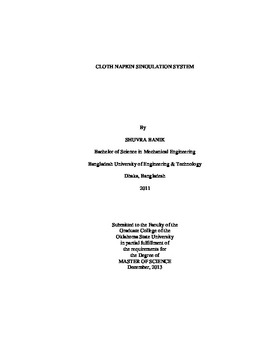| dc.contributor.advisor | Hoberock, Lawrence L. | |
| dc.contributor.author | Banik, Shuvra | |
| dc.date.accessioned | 2015-06-17T20:04:42Z | |
| dc.date.available | 2015-06-17T20:04:42Z | |
| dc.date.issued | 2013-12-01 | |
| dc.identifier.uri | https://hdl.handle.net/11244/14708 | |
| dc.description.abstract | Food service establishments serve food to many customers daily reusing a small inventory of silverware pieces. These silverware pieces are washed after each use and sets of pieces (e.g., a spoon, a soup spoon, a fork, and a knife per set) are often wrapped in napkins for using during further food serving. Upscale restaurants generally use cloth napkins, while others use paper napkins. Whether it is a cloth napkin or paper napkin, manual wrapping of silverware pieces in napkins is repetitive, tedious, and labor-intensive. Hence automation of wrapping of silverware pieces is highly desirable. One major component of an automated silverware wrapping system is a napkin singulator to feed the wrapping system with singulated napkins to be used for wrapping. This study investigates the design and construction of a cloth napkin singulation system, capable of singulating cloth napkins from a given stack of napkins without human interaction. The method of this study has been primarily experimental. A reliable cloth napkin singulation system with high accuracy has been designed, developed, constructed and evaluated. The system utilizes an adhesive tape to pick a napkin from a stack of napkins and a mechanism utilizing a linear actuator to remove the picked napkin from the adhesive tape near an upstream conveyor end. Then the removed napkin is passed along the moving conveyor to be fed to a silverware wrapping system, and the cycle is repeated until all napkins in the feed stack have been singulated. Results of evaluation demonstrate development of a cloth napkin singulation system with a high average singulation efficiency of 96%, which is a 14% increase over the earlier version of this mechanism. Also the system developed in this study is completely automated, unlike the earlier one. The average singulation time for each napkin cycle achieved by this system is 1.34 minutes, but this time can easily be decreased by employing higher speed carriage drive motors. | |
| dc.format | application/pdf | |
| dc.language | en_US | |
| dc.publisher | Oklahoma State University | |
| dc.rights | Copyright is held by the author who has granted the Oklahoma State University Library the non-exclusive right to share this material in its institutional repository. Contact Digital Library Services at lib-dls@okstate.edu or 405-744-9161 for the permission policy on the use, reproduction or distribution of this material. | |
| dc.title | Cloth Napkin Singulation System | |
| dc.type | text | |
| dc.contributor.committeeMember | Young, Gary E. | |
| dc.contributor.committeeMember | Hagan, Martin T. | |
| osu.filename | Banik_okstate_0664M_13036.pdf | |
| osu.accesstype | Open Access | |
| dc.description.department | Mechanical Engineering | |
| dc.type.genre | Thesis | |
| dc.subject.keywords | automation of post-dishwashing processes | |
| dc.subject.keywords | cloth napkin singulation system | |
| dc.subject.keywords | food service establishments | |
| dc.subject.keywords | silverware wrapping | |
| dc.subject.keywords | singulation of cloth napkins | |
